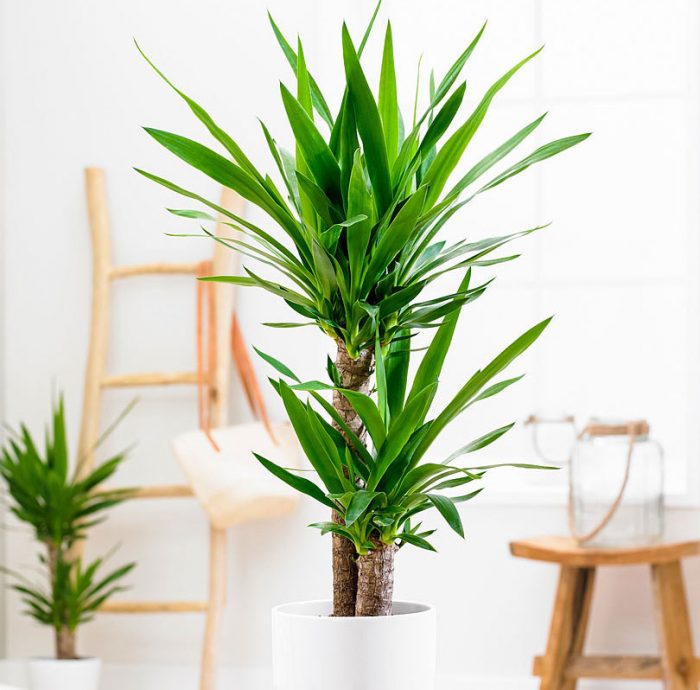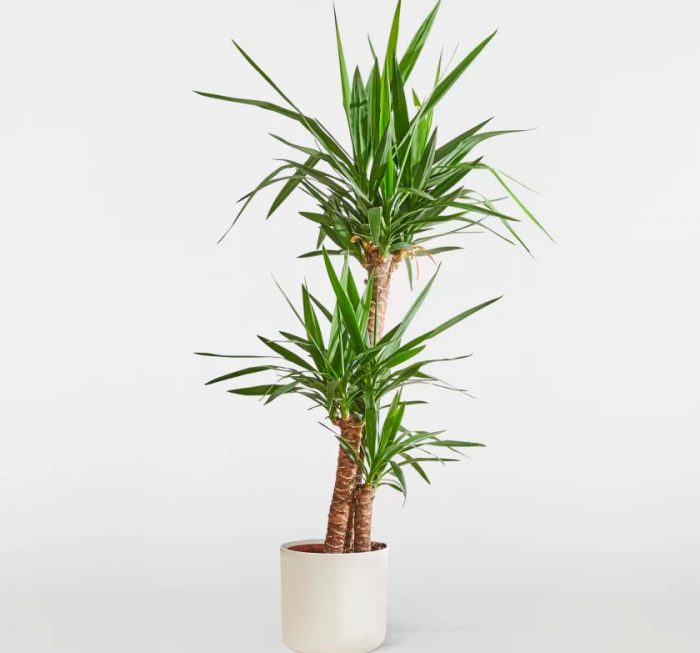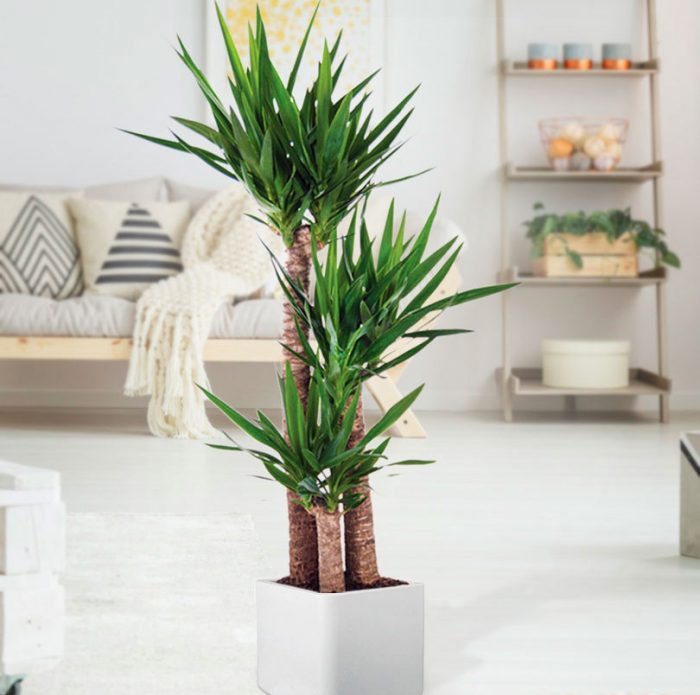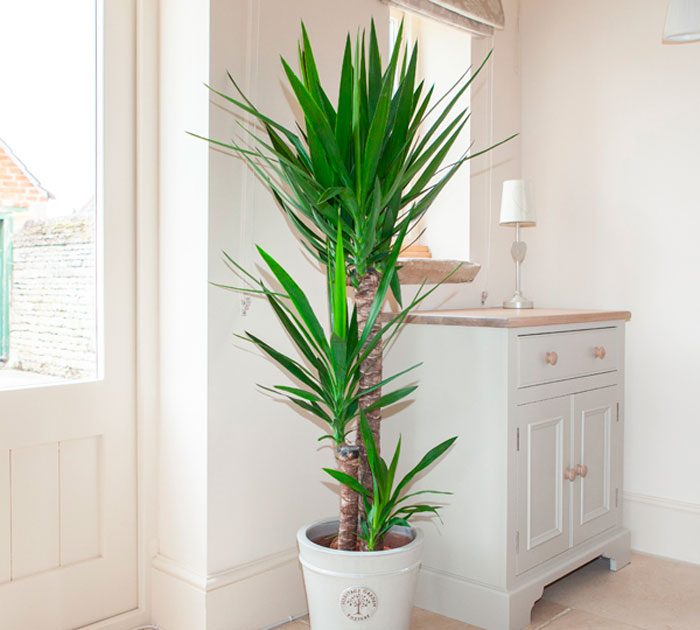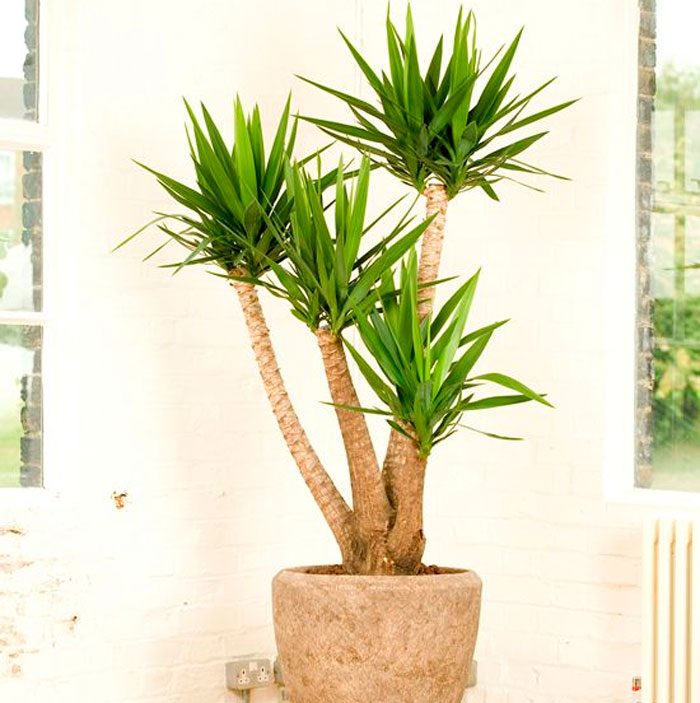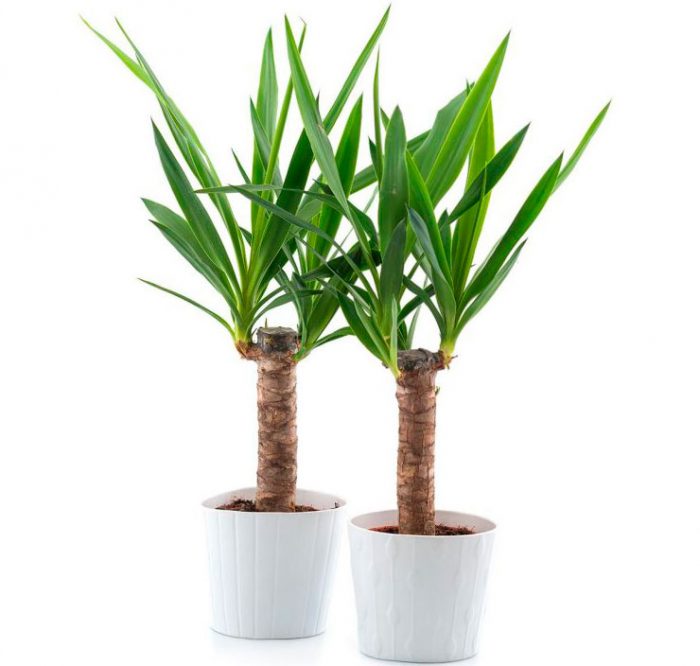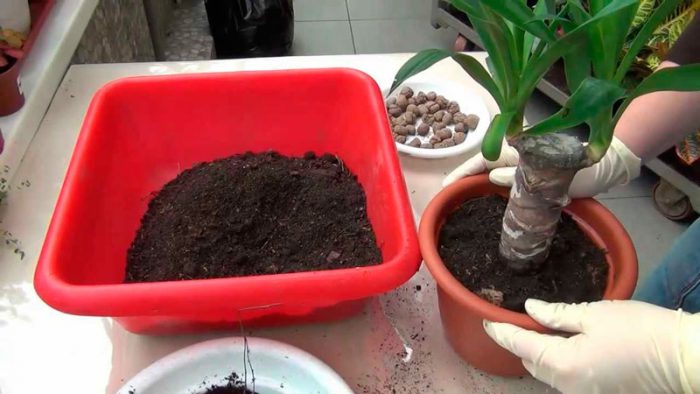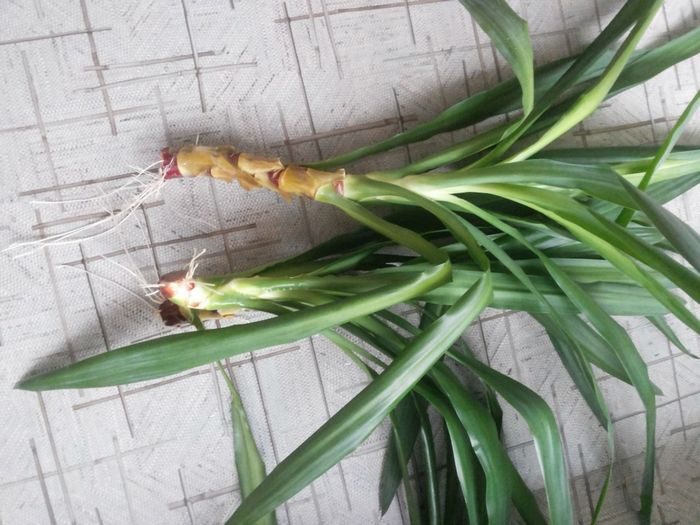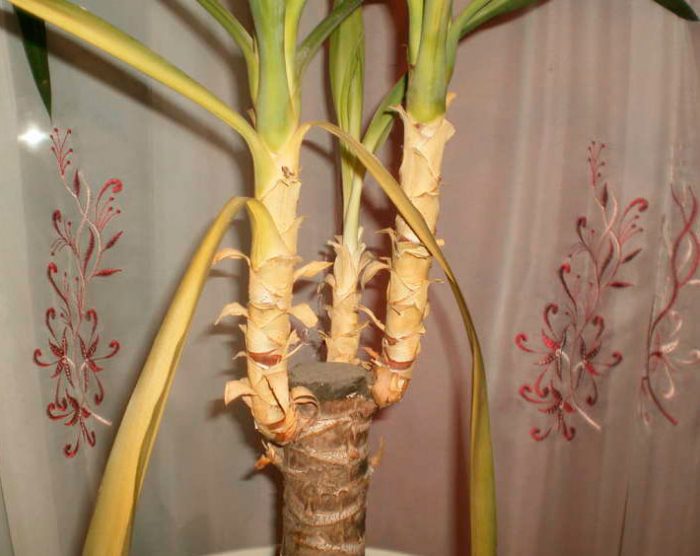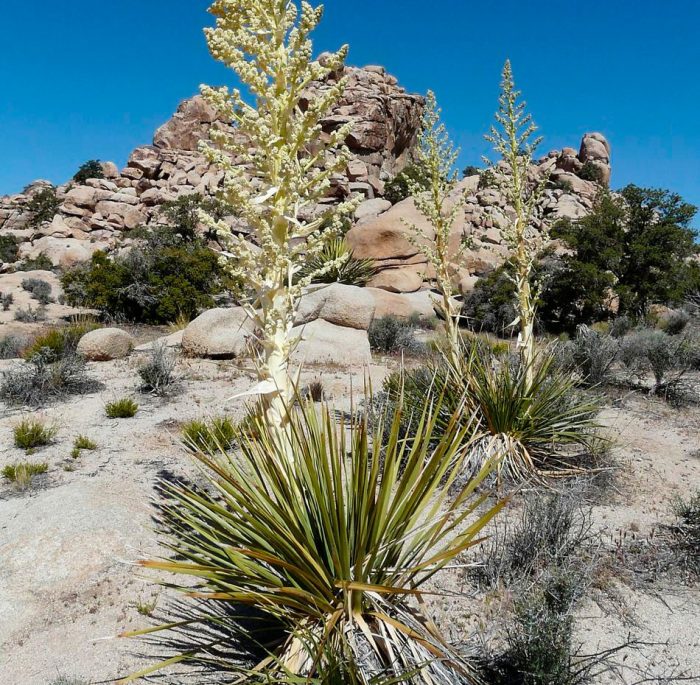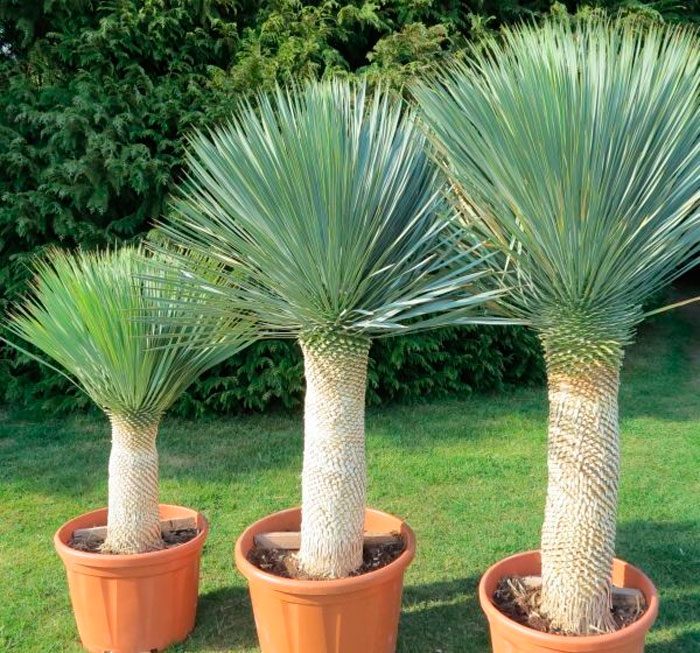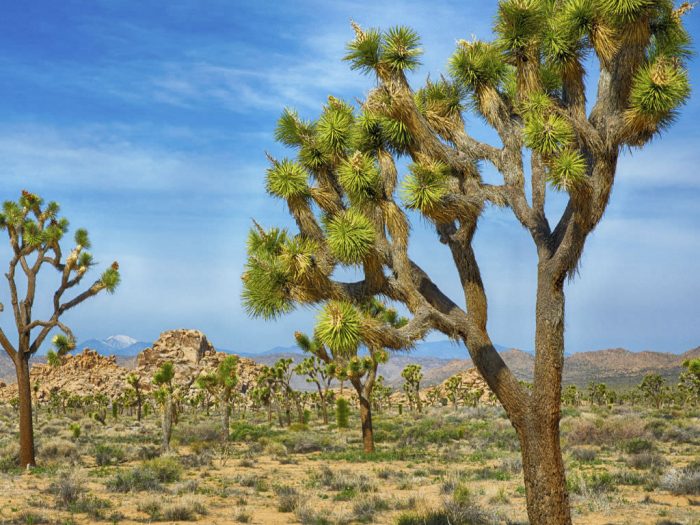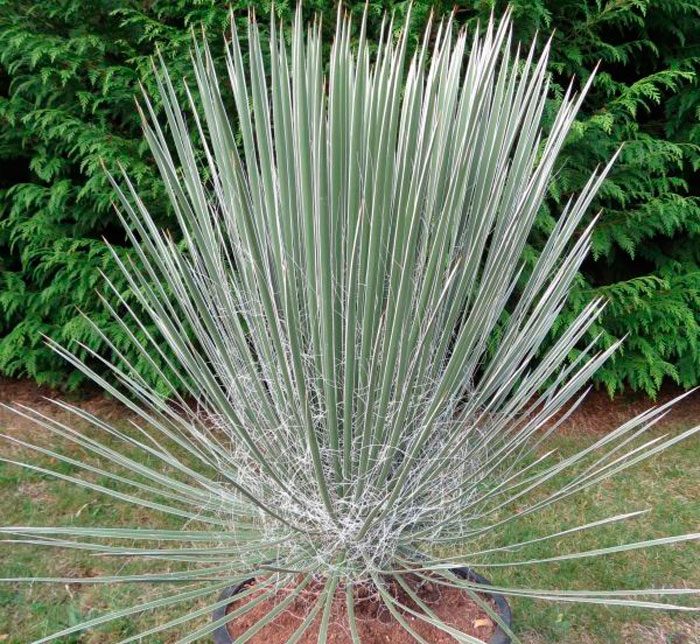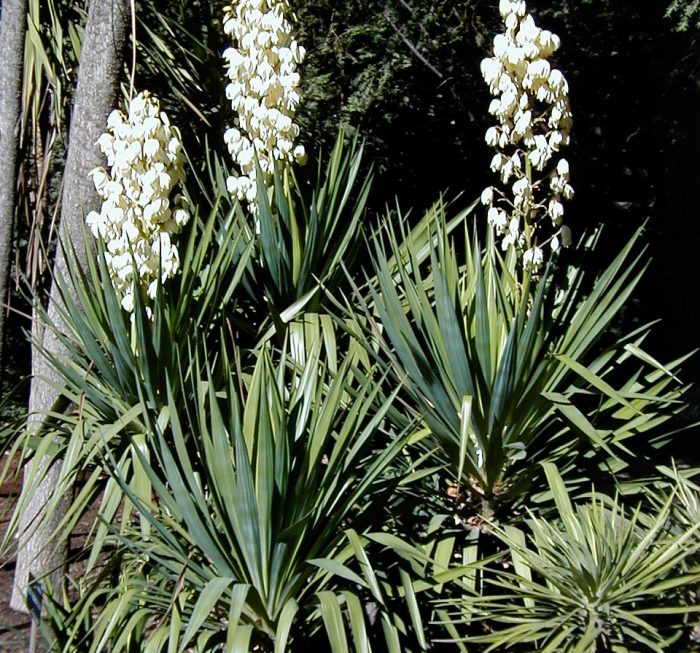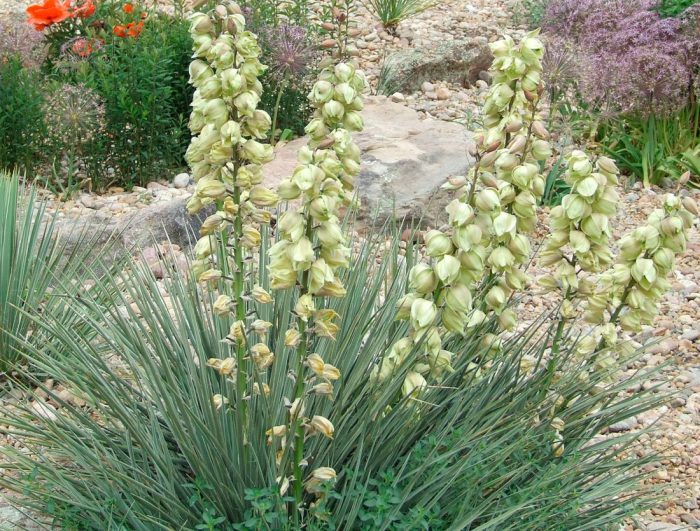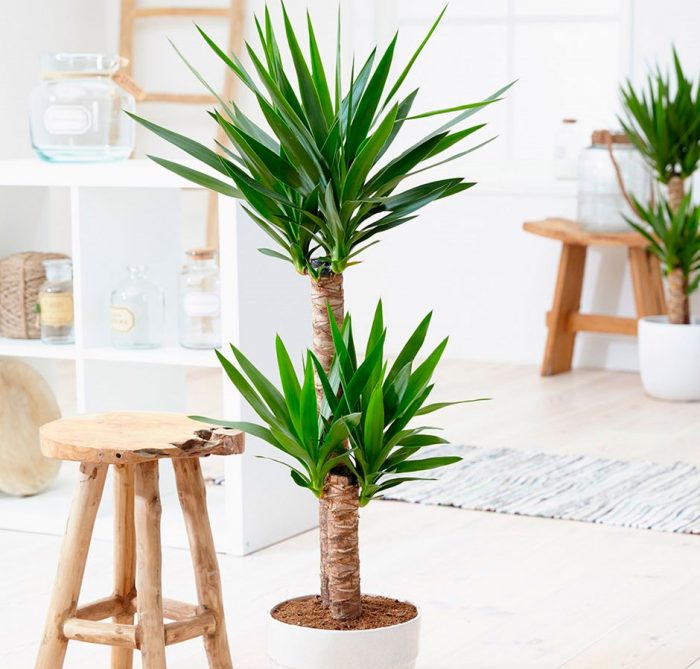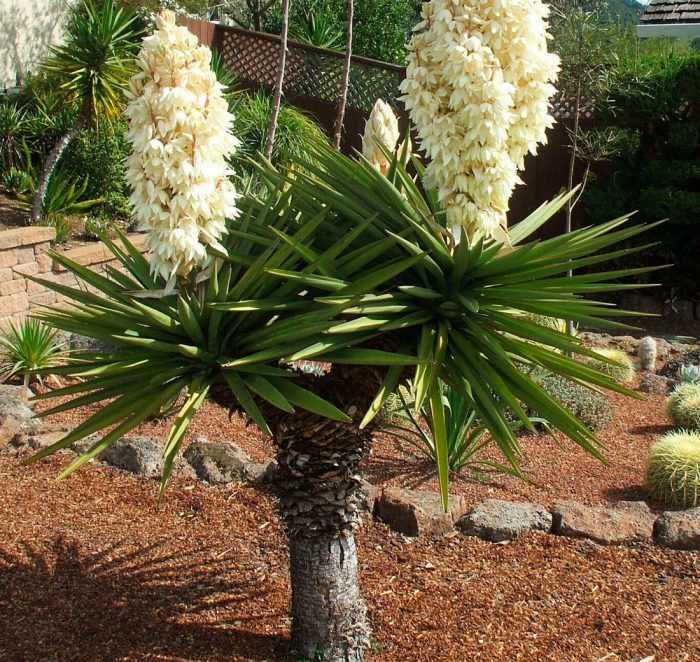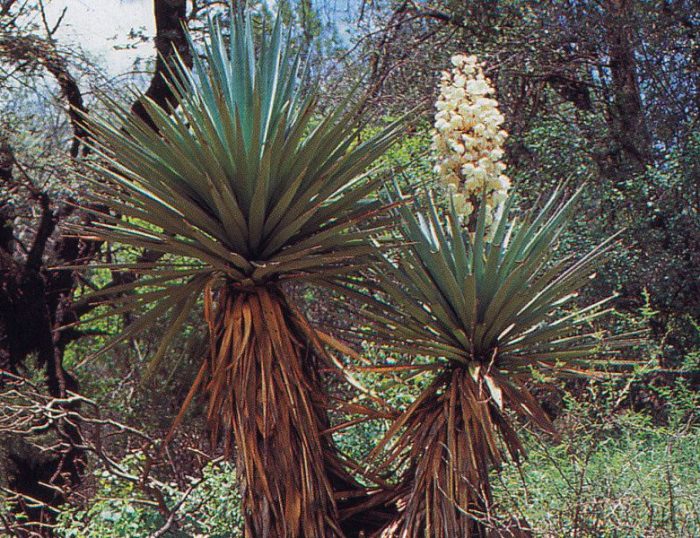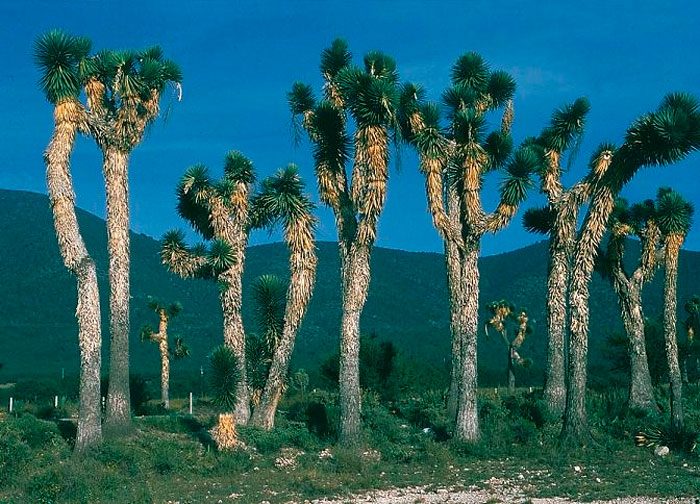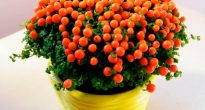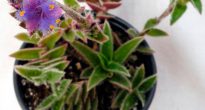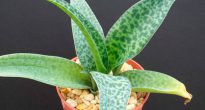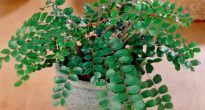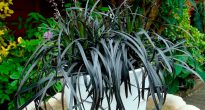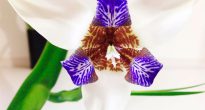The perennial tree-like plant, Yucca, is part of the Agave family. This genus unites about 40 species that are naturally found in the subtropical zone of North America. In the homeland of such a plant, it is used in various fields. From cut flowers, juice is extracted, which is high in sugar. Strong fibers are made from filamentous yucca, they were used to make the first jeans, and then cotton came to replace them. However, even today in the United States, yucca is added to the fabric used to make jeans, making it stronger and more durable. In addition, yucca fibers are used to make rope and paper, plus all this plant has healing properties.
Content
- 1 Yucca features
- 2 Brief description of cultivation
- 3 Yucca care at home
- 4 Reproduction methods
- 5 Possible problems
- 6 Types of yucca with photos and names
- 6.1 Yucca aloe leaf (Yucca aloifolia)
- 6.2 Yucca whipplei
- 6.3 Yucca beak (Yucca rostrata)
- 6.4 Short-leaved Yucca (Yucca brevifolia)
- 6.5 Yucca radiosa (Yucca radiosa)
- 6.6 Yucca filamentosa (Yucca filamentosa)
- 6.7 Yucca lipped-leaved (Yucca recurvifolia)
- 6.8 Yucca glauca
- 6.9 Yucca gloriosa
- 6.10 Yucca elephantipes
- 6.11 Yucca treculeana
- 6.12 Yucca schottii
- 6.13 Southern Yucca (Yucca australis)
Yucca features
Yucca is an evergreen plant with a low stem that may or may not branch at all. In some species, the stem is impossible to discern, while large spectacular leaf plates rise immediately above the soil surface, which are placed in a spiral. Large erect inflorescences reach about 200 centimeters in length, they grow from the middle of the leaf rosette and have a panicle shape. The bell-shaped drooping flowers reach about 70 mm in length, they have a white color. The fruit is a ten-centimeter box, inside of which there are black seeds, up to 10 mm in diameter.
When grown at home, the tree is recommended to be placed in a hall or a large room, because it can reach a height of about four meters. Such a plant looks very similar to a false palm tree. It should be borne in mind that flowering is observed only in an adult yucca, during which white flowers appear outwardly similar to bells. Such a plant is often used as a decoration for a large room, while those bushes that have several points of growth (a branching trunk) are of the greatest value.
Brief description of cultivation
- Bloom... Yucca is grown at home as a decorative deciduous large-sized tree.
- Illumination... Needs bright light, which must be necessarily diffused.
- Temperature regime... In the spring and summer, the plant feels comfortable at temperatures from 20 to 25 degrees, in the autumn and winter, the room should not be warmer than 12 degrees.
- Watering... Immediately after the top layer of the substrate in the pot has dried to a depth of 50 mm, the plant is watered abundantly.
- Air humidity... Air humidity requirements depend on the type of yucca. Some species need systematic humidification from a spray bottle, a regular warm shower, and it is also recommended to pour moistened expanded clay into the pallet. However, some of the species grow under normal air humidity typical of living rooms.
- Fertilizers... In the spring-summer period, feeding is carried out 1 time in 15–20 days for this, a mineral complex fertilizer is used in half the dosage recommended by the manufacturer. The seamy surface of the leaf plates is moistened with a nutrient solution.
- Dormant period... Not pronounced.
- Transfer... It is carried out only if necessary after the root system becomes very cramped in the pot. This procedure is best carried out in the spring, while in the summer it is transplanted only when absolutely necessary. It is not recommended to replant very large bushes, but they need to replace the top layer of the substrate in the container every year.
- Soil mixture... The substrate should be neutral with a pH of 6.0–6.5. If possible, it is better to buy a ready-made soil mixture for yucca, while adding 30 percent of the sand (of the total volume) to it.
- Reproduction... Trunk sections, cuttings and seed method.
- Harmful insects... Whiteflies, spider mites, scale insects, and mealybugs.
- Diseases... If the plant is improperly taken care of or not provided with suitable conditions for growth, then its foliage may lose its decorative effect.
Yucca care at home
Illumination
When grown indoors, yucca should be provided with very bright lighting, since it is light-requiring. However, despite this, the flower should be shaded from the direct rays of the sun, especially if it stands near south-facing windows. It grows best on the west and east windows. If natural lighting is too scarce, then the bush must be illuminated for at least 16 hours a day with fluorescent lamps, for this they are installed at a distance of 0.3–0.6 m from the plant. In the warm season, if desired, the yucca can be transferred to the street, while for it you need to choose a place that will be protected from direct sunlight, as well as from rain. If in the summer it is in the room, then it should be systematically and quite often ventilated.
Temperature regime
In spring and summer, make sure that the room is no colder than 20 degrees and not warmer - 25 degrees. If the tree has been exposed to direct sunlight for a long time, then it must be rearranged in a shaded place, and after it has cooled down, it is moistened with a sprayer. In the autumn-winter period, the air temperature should not be higher than 12 degrees.
If, during a warm winter, the lighting in the room is too poor, then the bases of the stems may stretch out, and the foliage will become thin, faded and lethargic. If the yucca weakens, it can cause an invasion of harmful insects, while the foliage turns yellow and flies around. If you cannot provide the plant with a temperature of 10 to 12 degrees in winter, then in the fall it is kept outside until the coldest days, and in the spring it is transferred to fresh air as early as possible. If the bush on the street is placed in a protected place, then even short-term frosts cannot harm it.
Watering
The following factors affect the frequency and abundance of watering a crop:
- temperature and humidity level;
- the size of the pot and the material from which it is made;
- bush size;
- characteristics of the substrate.
In the spring-summer period, watering should be abundant, it is carried out immediately after the top layer of the soil mixture dries out to a depth of about 50 mm. If the weather is hot in summer, then watering should be more frequent, but still between them, the surface of the soil mixture should have time to dry out. If the yucca is cool, then the amount of watering is reduced, otherwise liquid will stagnate in the soil mixture, which will cause rot on the plant, and this can lead to its death.
Air humidity
Part of the yucca species when grown at home must be systematically moistened from a sprayer. To do this, use boiled water at room temperature. To maintain high air humidity, moistened pebbles or gravel can be poured into the pan. While wetting the bush, it should be protected from direct sunlight, otherwise burns may form on its surface. In order to remove dust and dirt from the foliage, the bush can sometimes be washed under a warm shower, while the surface of the substrate must be protected from liquid ingress.
Fertilizer
In spring and summer, such a crop should be fed regularly once every 15–20 days. For this, a diluted mineral complex fertilizer is used. The plant responds well to feeding with infusion of mullein, leaf humus or horse manure. However, experienced florists recommend spraying the seamy surface of the leaf plates with a solution of a complex mineral fertilizer. If the plant is sick or it was transplanted not so long ago, then feeding should be suspended, since at this time they can only harm it.
Pruning
As a rule, a yucca has only 1 trunk, but with proper pruning, it can form several trunks. To do this, you need a young bush, which must be healthy and strong, while its height must be at least 0.3 m. In the last spring or first summer weeks, cut off the upper part of the bush, for this you need to use a very sharp tool. You need to cut off only 50–100 mm, but so that as much foliage as possible remains on the bush. Be sure to process the cuts, for this they are sprinkled with coal powder.
Yucca transplant
It is better to transplant the yucca in the spring, but it can also be done in the summer, if the need arises. At the bottom of the container, before planting, you need to make a good drainage layer; for this, use expanded clay, pebbles or broken brick. The substrate should be medium neutral with a pH of 6.0–6.5 if it contains peat. About 30 percent of the sand (of the total volume of the substrate) should be poured into the finished soil mixture.
It is recommended to replant the yucca using the transshipment method, while trying to keep the clod intact. If rot appears on the root system, for example, due to stagnation of liquid in the substrate, then the plant must be transplanted as soon as possible, while the decayed areas are cut out. Yucca works well for hydroponic cultivation.
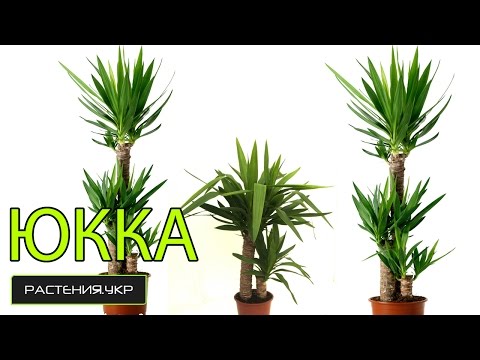

Watch this video on YouTube
Reproduction methods
Growing from seeds
If desired, yucca can be grown from seeds. For this, freshly harvested seeds are sown in a substrate consisting of turf and leafy soil, as well as sand, which are taken in equal parts. Crops should be systematically watered, ventilated, and condensate must be removed from the surface of the shelter. The first seedlings should appear after about one month. After the seedlings grow up and get stronger, they will need to be cut into individual pots, reaching about 60 mm in diameter. Then they begin to gradually accustom them to the same care that an adult plant needs. After 12 months, the plants will need to be transferred to larger pots (20-30 mm larger in diameter than the previous ones).
Reproduction by a trunk segment
Since such a plant grows very much at home, it is propagated by a piece of the trunk, if there is such a need. In the summer, several parts must be cut off from the trunk, while in length they must reach more than 20 centimeters. Sections are planted for rooting in a slightly moistened soil mixture consisting of peat and sand, while the cut should be at the bottom. Then the box is transferred outside to a shaded place. On the parent bush, all the places of the cuts are covered with garden var. The planted segments must be covered with a film on top, it will help maintain the required level of air humidity, while the air temperature should be from 20 to 24 degrees. Keep the soil slightly damp at all times. Rooting of the segments will occur after 4–8 weeks.
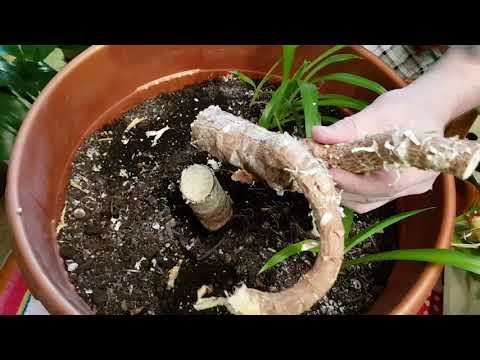

Watch this video on YouTube
Cuttings
For propagation of such a plant, apical cuttings are also used. Using a very sharp tool, cut off the top of the plant, while the cuts are treated with coal powder. The cutting should be left in the open air for 2 hours so that the cut sites have time to dry out. Then it is planted for rooting in moistened sand or placed in a container with boiled water. When rooting cuttings in water, a piece of charcoal is placed in a container, it must protect the cuttings from bacteria. Before the roots appear, rot may appear on the lower leaf plates. If this happens, then the leaves are removed, and the water in the container is changed. After the roots grow, the cutting is planted in a pot filled with soil mixture.
Possible problems
- Yucca turns yellow... When the lower leaf plates turn yellow in yucca, you should not be afraid, as this is a natural process. The fact is that green leaf plates can be found only at the top of the bush. The unusual appearance of such a plant is due precisely to the fact that it sheds the lower leaf plates.
- Leaves fall... If part of the foliage flew around after the flower was bought and brought home or after transplantation, then this is his fully expected reaction to a change in familiar conditions. In the event that the foliage flies around in large quantities, then this may be due to hypothermia of the plant or to the fact that it was exposed to a draft.
- Leaf tips dry and turn brown... Due to the extremely low air humidity, the tips, as well as the edge of the sheet plates, dry out and turn brown. It can also happen due to a draft or due to excessively rare or poor watering.
- Brown spots on the leaves... If brown spots form on the plate, this indicates that the clod of earth in the pot is dry.
- Leaves curl... If the room is very cold, then the edge of the foliage turns brown, and the plates themselves curl. In especially delicate species, this can happen if it is cold at night, and you forget to remove the flower from the windowsill.
- Spots on foliage... Sometimes, due to the scorching rays of the sun, dry spots of light color are formed on the surface of the leaf plates.
- Harmful insects... The plant most often settles such pests as: whitefly, spider mite, shield and mealybug.
Types of yucca with photos and names
Yucca aloe leaf (Yucca aloifolia)
In nature, this species is found in Jamaica, Central America, Bermuda, and also in the south of North America. The plant is extremely slow growing, but it can reach a height of about 8 meters. The tree-like stem in adult plants is highly branching. Rosettes with fibrous foliage are formed on the tops of the branches. The length of the lanceolate leaf plates is about 50 centimeters, they are dark green with a spike at the top and a serrated edge. In an adult bush, flowering is observed in the summer, at which time a panicle-shaped inflorescence is formed, reaching half a meter in length.It grows out of a rosette and includes many bell-shaped flowers in its composition, reaching 30 mm in diameter, they are painted in a whitish-cream shade with a purple tint.
Yucca whipplei
In nature, this bushy, slow-growing plant is found in California, Mexico and Arizona. Its stalk is short, and rigid and fibrous leaf plates are collected in rosettes, which reach about 100 cm in diameter.The leathery greenish-gray foliage of the lanceolate shape is about 100 cm long, has a thorn at the top, and teeth along the edge. The inflorescence of this species is practically the same as that of the aloe-leaf yucca, only it is longer (about 200 cm), and the flowers of the same color have a pleasant smell and are 5 mm larger. When flowering ends, the rosette dies off, and many shoots form at the base of the plant.
Yucca beak (Yucca rostrata)
This tree, with a thick trunk, can reach a height of about 300 cm, its crown is highly branched. There are a large number of leathery to the touch thin (up to 10 mm wide) and long sheet plates, which can be convex or flat. There is a sharp spike at the top of the plate, and small teeth grow on the yellow edge. The leaf itself is decorated with stripes. On a long peduncle, a panicle is formed, consisting of white flowers.
Short-leaved Yucca (Yucca brevifolia)
Either tree yucca (Yucca arborescens) or giant yucca. In nature, the species can be found in southeastern California, and also in Arizona, mainly in dry parts. The height of the tree can reach up to 9 meters, and its trunk diameter reaches 50 centimeters. In the upper part, the trunk is strongly branched. Densely growing hard and short foliage (length about 0.3 m) in the middle part reaches about 15 mm in width, on the surface it has a groove, and at the top of the thorn, the edge is finely toothed. At the top, the leaf is brown. The short peduncle consists of yellowish flowers.
Yucca radiosa (Yucca radiosa)
Or high yucca (Yucca elata). The height of such a tree is about 7 meters. It has a lot of densely spaced sheet plates of a linear shape, their length is about 0.6 meters, and at the widest point their width is only 10 mm. The plate tapers to the base, its top is pointed, there are small grooves. The narrow white edges of the foliage are covered with many fine threads. The length of the inflorescence is about 2 meters, at the top of it there are flowers collected in a panicle.
Yucca filamentosa (Yucca filamentosa)
This plant comes from the east of North America. Its stem is practically absent. The root system goes into deep soil layers. Such a plant is able to grow strongly due to root suckers. It can withstand a short-term temperature drop to minus 20 degrees. The leaf plates pointed at the top have a greenish-bluish color, along the edge they are densely pubescent with thin curly white threads. The foliage is about 0.7 m long and up to 40 mm wide. To get viable seeds, the plant must be artificially pollinated. On a two-meter peduncle, a lot of drooping eight-centimeter flowers of a yellowish-white color are formed. After flowering, a fruit is formed - a rounded box.
Yucca lipped-leaved (Yucca recurvifolia)
The trunk of such a plant is short (height is about half a meter), in some cases it is highly branching. At its top, rigid fibrous sheet plates are assembled into a socket. The grayish-green drooping foliage, leathery to the touch, has a lanceolate shape and is about 100 cm long, has a thorn at the top, and a jagged edge.
Yucca glauca
Such an evergreen plant reaches a height of about 200 cm, its homeland is the western United States. Its stem is short. Meter rosettes consist of densely packed leathery fibrous foliage. Lanceolate bluish-green leaf plates with a white edge reach about 0.6 m in length.The edging can also be gray with peeling fibers. In adult plants, in summer, a panicle-shaped inflorescence grows from the rosette, reaching a height of 100 cm. It consists of many bell-shaped flowers of a creamy white hue.
Yucca gloriosa
Originally from the southeastern United States. In nature, the species is a spherical bush or a low tree (about 2 m). The tree-like stem can be weakly branching or single. Leathery to the touch, lanceolate bluish-green leaf plates reach up to 0.6 m in length, they have a sharp spike at the top, and the edge is sparsely toothed. In adult plants, in the summer, a panicle-shaped inflorescence grows from the outlet, reaching a height of about 250 cm. Many five-centimeter hanging flowers of a creamy color with a purple tint are formed on it.
Yucca elephantipes
The fact is that this plant looks like an elephant's leg. Over time, it becomes a not very tall tree or upright bush and has a height of about 10 meters. Its stem is tree-like, strongly branching. At the tops of the branches are leaf rosettes consisting of rigid fibrous plates. Greenish leathery to the touch, lanceolate leaf plates are 50–100 cm long, their edge is serrated, and there is a sharp thorn at the top. In summer, adult plants form an inflorescence about 100 cm long, which consists of many five-centimeter flowers.
Yucca treculeana
Native to Mexico and the southern United States. The weakly branching tree-like stem is characterized by slow growth, in height it can reach about 5 meters. Leathery to the touch, bluish-green lanceolate leaf plates are collected in a dense rosette, they are straight or slightly curved, pointed at the top, their length is more than 100 cm, and their width is up to 7 centimeters. In summer, in adult bushes, an inflorescence about 100 cm long appears from the outlet; it consists of many hanging bell-shaped flowers of white color with a purple tint.
Yucca schottii
Or large-fruited yucca (Yucca macrocarpa). The species grows on sandy ground in southern Arizona. A weakly branched or straight trunk reaches a height of about 4 meters. Rigid light-gray straight leaf plates are about 50 cm long and up to 4 cm wide. The plate narrows slightly at the base, and its edge is covered with thin threads. The branches and peduncle are bent, and the loose inflorescence has a panicle shape.
Southern Yucca (Yucca australis)
Or yucca filamentary (Yucca filifera). The height of the tree is about 10 meters, its upper part is strongly branching. Densely growing dark green leafy plates, leathery to the touch, are about 30 centimeters long, and up to 3 centimeters wide, their edge is covered with threads. During flowering, a branched, hanging two-meter inflorescence is formed, which consists of a large number of cream-colored flowers.
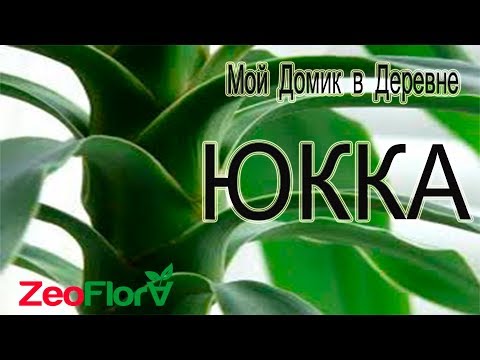

Watch this video on YouTube

